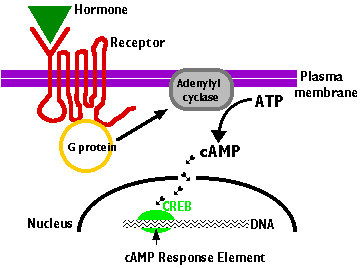| Index to this page |
| Link to a table of the hormones containing links to the individual hormones |
| Link to diagram showing locations of the endocrine glands (92K) |
The essence of multicellularity is the coordinated interaction of the various kinds of cells that make up the body. Cells communicate with each other by chemical signals.
Three kinds of chemical signaling can be distinguished;| Link to a discussion of mechanisms by which cell signaling alters gene expression. |
This page will examine the properties of endocrine signaling.
These hydrophilic (and mostly large) hormone molecules bind to receptors on the surface of "target" cells; that is, cells able to respond to the presence of the hormone. These receptors are transmembrane proteins. Binding of the hormone to its receptor initiates a sequence of intracellular signals that may
 This is the sequence of events:
This is the sequence of events:
5' TGACGTCA 3'in the promoters of genes that are able to respond to the hormone, activated CREB turns on gene transcription.

Steroid hormones, being hydrophobic molecules, diffuse freely into all cells. However, their "target" cells contain cytoplasmic and/or nuclear proteins that serve as receptors of the hormone. The hormone binds to the receptor and the complex binds to hormone response elements — stretches of DNA within the promoters of genes responsive to the hormone. The hormone/receptor complex acts as a transcription factor turning target genes "on" (or "off").
Link to a stereo view of a steroid receptor complex bound to its response element.The levels of hormones circulating in the blood are tightly controlled by three homeostatic mechanisms:
Example: The follicle stimulating hormone (FSH) stimulates the release of estrogens from the ovarian follicle. A high level of estrogen, in turn, suppresses the further production of FSH. [View graphic]
Example: Insulin causes the level of blood sugar (glucose) to drop when it has risen. Glucagon causes it to rise when it has fallen.
Example: a rising level of Ca2+ in the blood suppresses the production of the parathyroid hormone (PTH). A low level of Ca2+ stimulates it.
Although a few hormones circulate simply dissolved in the blood, most are carried in the blood bound to plasma proteins. For example, all the steroid hormones, being highly hydrophobic, are transported bound to plasma proteins.
| Welcome&Next Search |